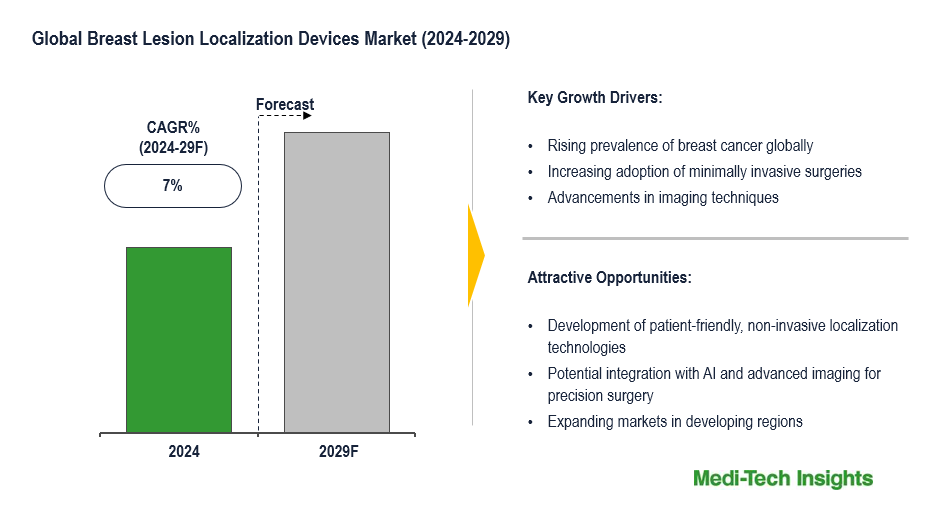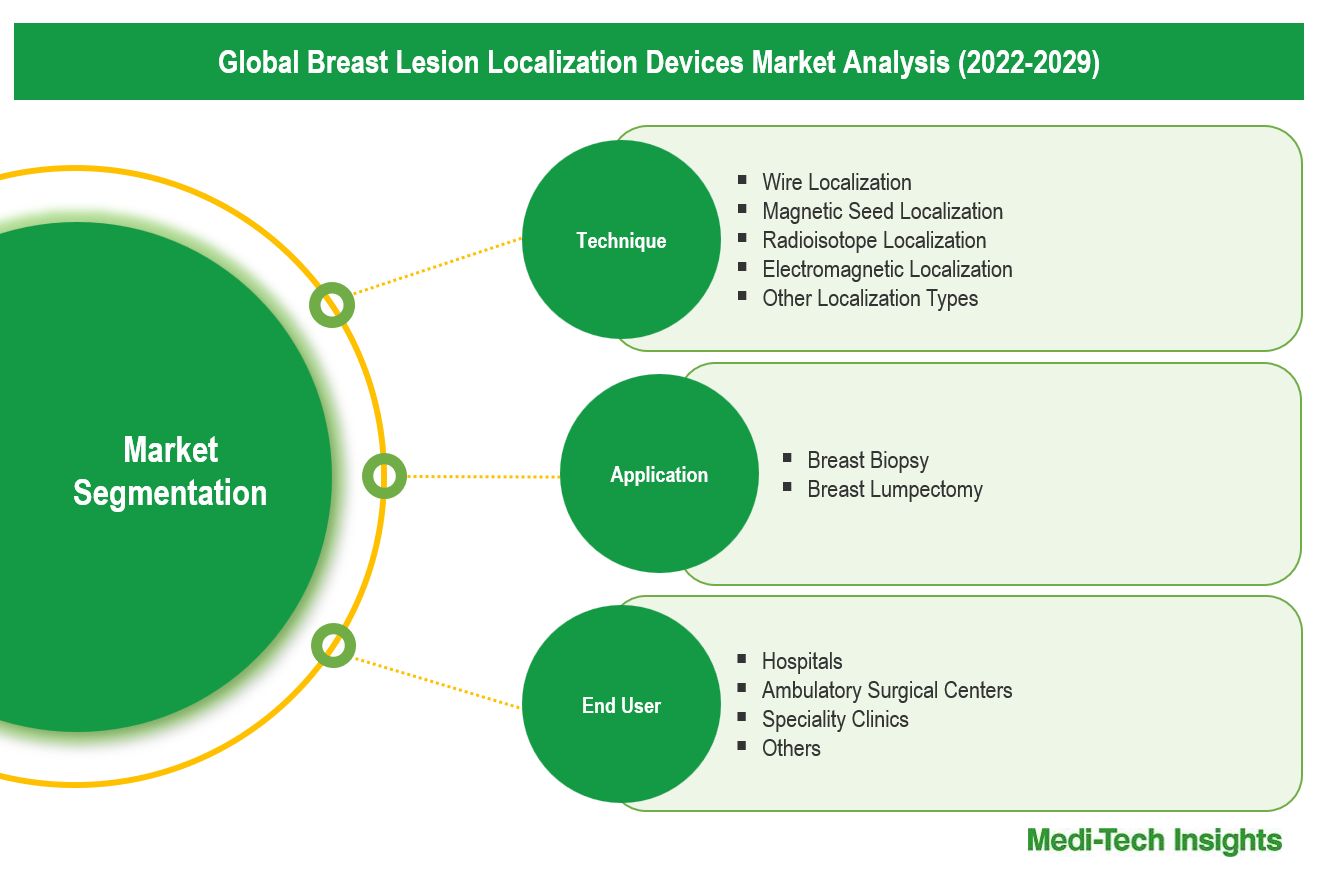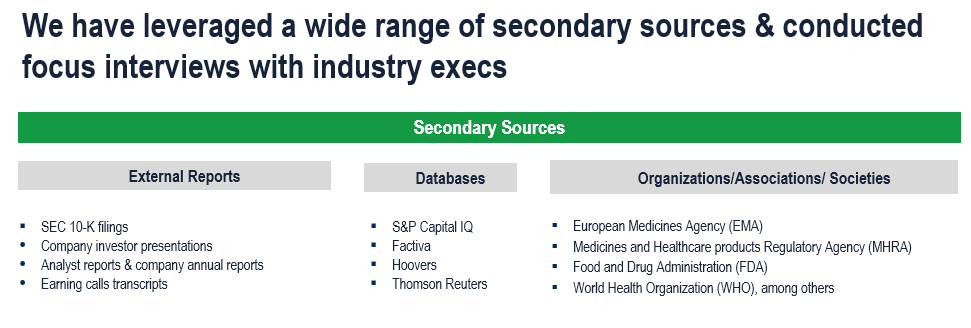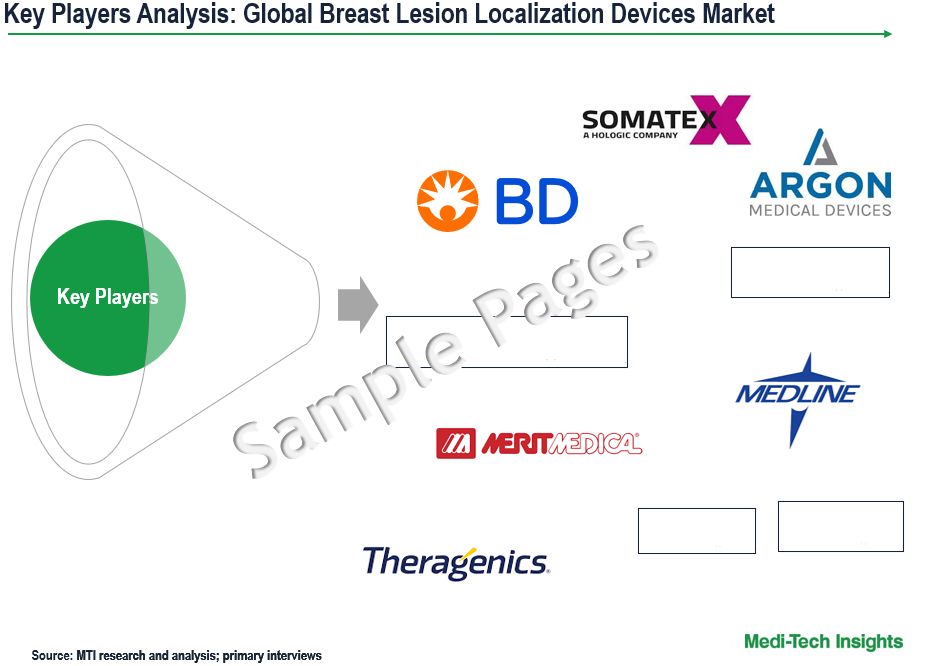
Breast Lesion Localization Devices Market Expected to Witness a Steady CAGR of 7% from 2024 to 2029
The breast lesion localization devices market is experiencing steady growth, with a CAGR of around 7% during the forecast period. This expansion is driven not only by the rising global incidence of breast cancer but also by the growing adoption of minimally invasive surgeries, which require precise localization of breast lesions. Additionally, increased awareness of breast cancer screening, advancements in imaging technologies, and the growing availability of sophisticated healthcare infrastructure are key factors contributing to market growth. However, high costs associated with advanced localization technologies and the lack of skilled professionals in some regions serve as potential restraints. To learn more about the research report, download a sample report.
Breast lesion localization devices are essential tools designed to accurately pinpoint the location of abnormal tissue within the breast, especially when the lesions are non-palpable or difficult to detect through touch. Typically identified via imaging techniques like mammography, ultrasound, or MRI, these lesions may be benign or malignant and often require surgical removal. Localization devices guide surgeons during biopsy or lumpectomy procedures, ensuring precise excision of the lesion while minimizing damage to surrounding healthy tissue. Traditional methods, such as wire-guided localization, have evolved into modern, patient-friendly technologies like radioactive seed and radar-based systems, which enhance surgical accuracy and improve patient comfort. These advanced tools are crucial for breast-conserving surgeries, ensuring better surgical outcomes by facilitating complete lesion removal while preserving breast aesthetics.

To learn more about this report, download the PDF brochure
Increasing Global Incidence of Breast Cancer and Early Detection Propel Device Adoption
One of the most compelling factors accelerating the demand for breast lesion localization devices is the growing global incidence of breast cancer, particularly among women health over the age of 40. As breast cancer has become the most frequently diagnosed cancer among women, early detection has become essential for improving survival rates. Advanced imaging techniques, such as 3D mammography and MRI, are allowing for earlier identification of suspicious lesions, which has led to a high demand for precision localization devices. These tools play a critical role in facilitating minimally invasive surgical procedures, reducing patient pain, minimizing complications, and speeding up recovery times. Additionally, robust government health initiatives promoting regular breast cancer screenings, along with expanding healthcare infrastructure in emerging markets, are further driving the adoption of these devices.
Emerging Wireless Technologies Revolutionizing Localization Methods
A key trend reshaping the breast lesion localization devices market is the shift towards wireless localization technologies, which are rapidly replacing wire-guided systems. Wireless devices, including radar or radiofrequency-based localization systems, offer significant advantages such as increased accuracy and improved patient comfort by eliminating the need for uncomfortable wire insertion procedures. These advanced systems also enhance surgical planning by allowing same-day procedures, which reduces the risks of wire displacement and decreases patient stress. The transition to non-invasive, patient-centric technologies is revolutionizing breast lesion management, leading to widespread adoption in healthcare facilities and improving outcomes for both patients and providers.

To learn more about this report, download the PDF brochure
Competitive Landscape Analysis
The global breast lesion localization devices market is marked by the presence of established and emerging market players such as Becton, Dickinson and Company; SOMATEX Medical Technologies GmbH (Hologic Company); Argon Medical Devices; Merit Medical Systems; Cook Medical; Mediline Industries Inc.; STERYLAB S.r.l.; Theragenics Corporation; MDL SRL; MOLLI Surgical (Stryker); among others. Some of the key strategies adopted by market players include product innovation and development, strategic partnerships and collaborations, and geographic expansion.
Breast Lesion Localization Devices Market Scope
|
Report Scope |
Details |
|
Base Year Considered |
2023 |
|
Historical Data |
2022 – 2023 |
|
Forecast Period |
2024 – 2029 |
|
Growth Rate |
CAGR of 7% |
|
Segment Scope |
Technique, Application, End User |
|
Regional Scope |
|
|
Key Companies Mapped |
Becton, Dickinson and Company; SOMATEX Medical Technologies GmbH (Hologic Company); Argon Medical Devices; Merit Medical Systems; Cook Medical; Mediline Industries Inc.; STERYLAB S.r.l.; Theragenics Corporation; MDL SRL; MOLLI Surgical (Stryker); among others |
|
Report Highlights |
Market Size & Forecast, Growth Drivers & Restraints, Trends, Competitive Analysis |
Key Strategic Questions Addressed
-
What is the market size & forecast of the breast lesion localization devices market?
-
What are historical, present, and forecasted market shares and growth rates of various segments and sub-segments of the breast lesion localization devices market?
-
What are the key trends defining the market?
-
What are the major factors impacting the market?
-
What are the opportunities prevailing in the market?
-
Which region has the highest share in the global market?
-
Which region is expected to witness the highest growth rate in the next 5 years?
-
Who are the major players operating in the market?
-
What are the key strategies adopted by players?
- Introduction
- Introduction
- Market Scope
- Market Definition
- Segments Covered
- Regional Segmentation
- Research Timeframe
- Currency Considered
- Study Limitations
- Stakeholders
- List of Abbreviations
- Key Conferences and Events (2023-2024)
- Research Methodology
- Secondary Research
- Primary Research
- Market Estimation
- Bottom-Up Approach
- Top-Down Approach
- Market Forecasting
- Executive Summary
- Breast Lesion Localization Devices Market Snapshot (2023-2029)
- Segment Overview
- Regional Snapshot
- Competitive Insights
- Market Overview
- Market Dynamics
- Drivers
- Rising prevalence of breast cancer globally
- Increasing adoption of minimally invasive surgeries
- Advancements in imaging techniques
- Government initiatives promoting breast cancer screening
- Increasing awareness of early detection and breast-conserving surgeries
- Restraints
- High cost of advanced localization devices
- Limited access to specialized care in developing regions
- Lack of skilled professionals
- Opportunities
- Development of patient-friendly, non-invasive localization technologies
- Expanding markets in developing regions with growing access to healthcare
- Key Market Trends
- Shift from wire-guided to wireless localization technologies
- Increasing use of image-guided procedures in breast surgery
- Unmet Market Needs
- Industry Speaks
- Regulatory Analysis
- Drivers
- Market Dynamics
- Global Breast Lesion Localization Devices Market Size & Forecast (2022-2029), By Technique, USD Million
- Introduction
- Wire Localization
- Magnetic Seed Localization
- Radioisotope Localization
- Electromagnetic Localization
- Other Localization Types
- Global Breast Lesion Localization Devices Market Size & Forecast (2022-2029), By Application, USD Million
- Introduction
- Breast Biopsy
- Breast Lumpectomy
- Global Breast Lesion Localization Devices Market Size & Forecast (2022-2029), By End User, USD Million
- Introduction
- Hospitals
- Ambulatory Surgical Centers
- Speciality Clinics
- Others
- Global Breast Lesion Localization Devices Market Size & Forecast (2022-2029), By Region, USD Million
- Introduction
- Breast Lesion Localization Devices Market Size & Forecast (2022-2029), By Country, USD Million
- US
- Market Size & Forecast, By Technique (USD Million)
- Market Size & Forecast, By Application (USD Million)
- Market Size & Forecast, By End User (USD Million)
- Canada
- Market Size & Forecast, By Technique (USD Million)
- Market Size & Forecast, By Application (USD Million)
- Market Size & Forecast, By End User (USD Million)
- Breast Lesion Localization Devices Market Size & Forecast (2022-2029), By Country, USD Million
- UK
- Market Size & Forecast, By Technique (USD Million)
- Market Size & Forecast, By Application (USD Million)
- Market Size & Forecast, By End User (USD Million)
- Germany
- Market Size & Forecast, By Technique (USD Million)
- Market Size & Forecast, By Application (USD Million)
- Market Size & Forecast, By End User (USD Million)
- France
- Market Size & Forecast, By Technique (USD Million)
- Market Size & Forecast, By Application (USD Million)
- Market Size & Forecast, By End User (USD Million)
- Italy
- Market Size & Forecast, By Technique (USD Million)
- Market Size & Forecast, By Application (USD Million)
- Market Size & Forecast, By End User (USD Million)
- Spain
- Market Size & Forecast, By Technique (USD Million)
- Market Size & Forecast, By Application (USD Million)
- Market Size & Forecast, By End User (USD Million)
- Rest of Europe
- Market Size & Forecast, By Technique (USD Million)
- Market Size & Forecast, By Application (USD Million)
- Market Size & Forecast, By End User (USD Million)
- Asia Pacific (APAC) Breast Lesion Localization Devices Market Size & Forecast (2022-2029), By Country, USD Million
- China
- Market Size & Forecast, By Technique (USD Million)
- Market Size & Forecast, By Application (USD Million)
- Market Size & Forecast, By End User (USD Million)
- Japan
- Market Size & Forecast, By Technique (USD Million)
- Market Size & Forecast, By Application (USD Million)
- Market Size & Forecast, By End User (USD Million)
- India
- Market Size & Forecast, By Technique (USD Million)
- Market Size & Forecast, By Application (USD Million)
- Market Size & Forecast, By End User (USD Million)
- Rest of Asia Pacific
- Market Size & Forecast, By Technique (USD Million)
- Market Size & Forecast, By Application (USD Million)
- Market Size & Forecast, By End User (USD Million)
- Latin America (LATAM) Breast Lesion Localization Devices Market Size & Forecast (2022-2029), USD Million
- Market Size & Forecast, By Technique (USD Million)
- Market Size & Forecast, By Application (USD Million)
- Market Size & Forecast, By End User (USD Million)
- Middle East & Africa (MEA) Breast Lesion Localization Devices Market Size & Forecast (2022-2029), USD Million
- Market Size & Forecast, By Technique (USD Million)
- Market Size & Forecast, By Application (USD Million)
- Market Size & Forecast, By End User (USD Million)
- China
- UK
- US
- Competitive Landscape
- Key Players and their Competitive Positioning
- Key Player Comparison
- Segment-wise Player Mapping
- Market Share Analysis (2023)
- Company Categorization Matrix
- Dominants/Leaders
- New Entrants
- Emerging Players
- Innovative Players
- Key Strategies Assessment, By Player (2022-2024)
- New Product Launches
- Partnerships, Agreements, & Collaborations
- Mergers & Acquisitions
- Geographic Expansion
- Key Players and their Competitive Positioning
- Company Profiles*
(Business Overview, Financial Performance**, Products Offered, Recent Developments)
- Becton, Dickinson and Company
- SOMATEX Medical Technologies GmbH (Hologic Company)
- Argon Medical Devices
- Merit Medical Systems
- Cook Medical
- Mediline Industries Inc.
- STERYLAB S.r.l.
- Theragenics Corporation
- MDL SRL
- MOLLI Surgical (Stryker)
- Other Prominent Players
The study has been compiled based on extensive primary and secondary research.
Secondary Research (Indicative List)

Primary Research
To validate research findings (market size & forecasts, market segmentation, market dynamics, competitive landscape, key industry trends, etc.), extensive primary interviews were conducted with both supply and demand-side stakeholders.
Supply Side Stakeholders:
- Senior Management Level: CEOs, Presidents, Vice-Presidents, Directors, Chief Technology Officers, Chief Commercial Officers
- Mid-Management Level: Product Managers, Sales Managers, Brand Managers, R&D Managers, Business Development Managers, Consultants
Demand Side Stakeholders:
- Hospitals, Ambulatory Surgical Centers, Speciality Clinics and Others
Breakdown of Primary Interviews

Market Size Estimation
Both ‘Top-Down & Bottom-Up Approaches’ were used to derive market size estimates and forecasts
Data Triangulation
Research findings derived through secondary sources & internal analysis was validated with Primary Interviews, Internal Knowledge Repository and Company’s Sales Data



